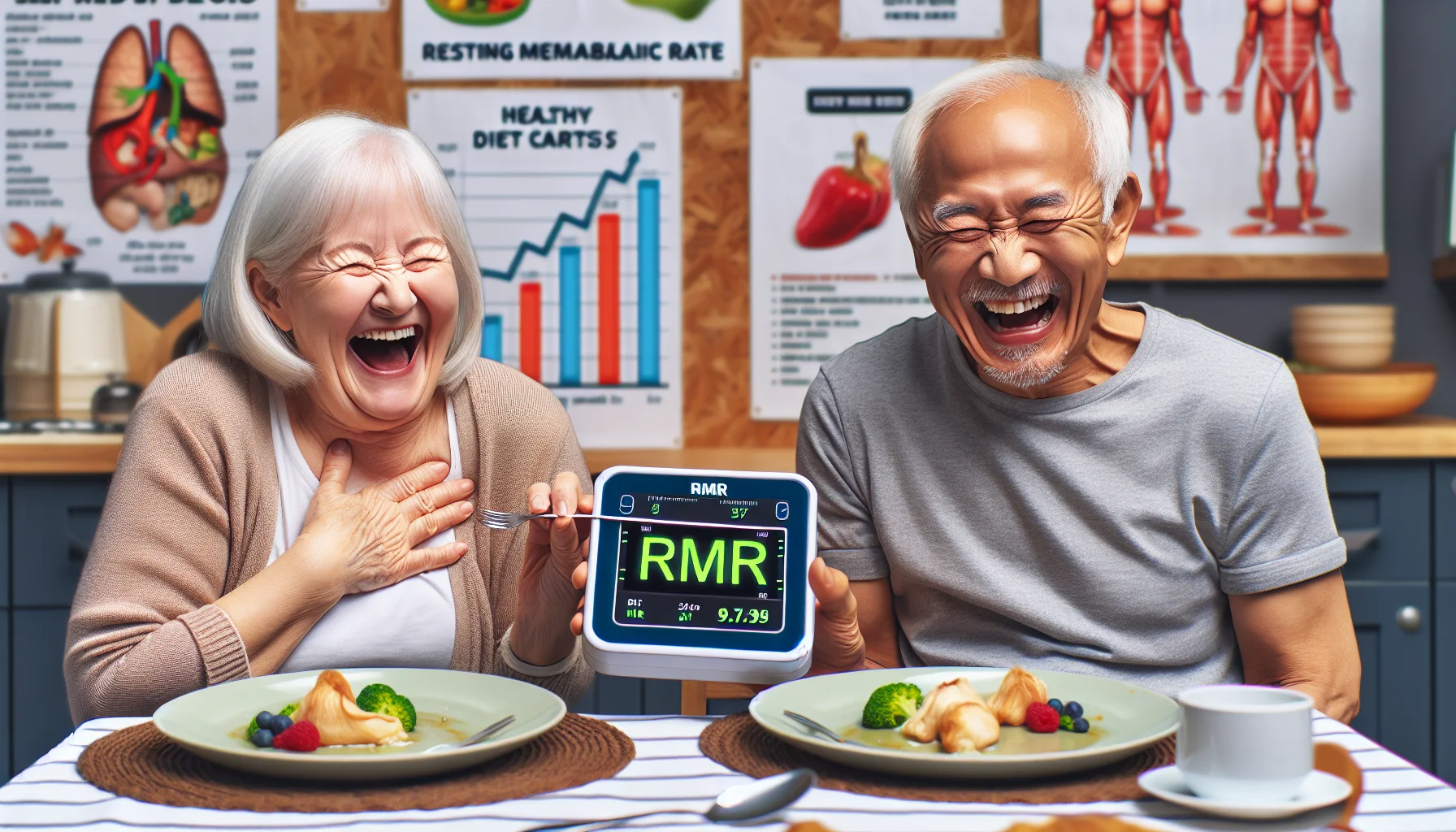Whats my rmr Quiz
Test Your Knowledge
Question of
Understanding Resting Metabolic Rate (RMR)
What is RMR?
Your Resting Metabolic Rate, or RMR, is the amount of energy your body uses to maintain basic functions while at rest. It's the number of calories you burn without any additional activity just keeping your body alive and ticking!
The Science Behind RMR is absolutely fascinating! It encompasses all the biological processes that keep you breathing, circulating blood, regulating temperature, and more. Your RMR accounts for a significant chunk of your daily energy expenditure up to 70-75%!
Various Factors Affecting Metabolic Rate include age, gender, muscle mass, and hormonal balance. Each plays a critical role in determining how fast or slow your metabolism works. It's like the ID card for your body's energy needs!
Now, lets talk about RMR vs. BMR: What's the Difference? BMR, or Basal Metabolic Rate, is often used interchangeably with RMR. However, BMR is measured under more restrictive conditions while RMR offers a more realistic measure of daily energy expenditure.
How to Calculate Your RMR
Unlock the secret to your body's energy use with RMR Calculation Formulas . The Mifflin-St Jeor Equation is one popular method that takes into account your weight, height, age, and sex. Calculating your RMR can be an eye-opener!
Tools and Tests for Measuring RMR range from high-tech metabolic carts to online calculators. For precise measurements, professionals use indirect calorimetry, which measures oxygen consumption and carbon dioxide production.
The muscular you are, the higher your RMR tends to be! This is because muscle tissue burns more calories at rest compared to fat tissue. So yes, bulking up on lean muscle does boost your metabolism its like upgrading your engine!
Importance of Knowing Your RMR
Tailoring Your Diet to Your Metabolic Rate could be a game-changer in managing your health and fitness. With knowledge of your RMR, you can design a meal plan that perfectly matches your body's energy needs. No more guesswork!
Weight Management and RMR : understanding this dynamic duo can help you crack the code to maintaining or altering your weight. When you know how many calories you burn at rest, you can better decide how many to consume or burn off during workouts.
- Setting Realistic Fitness Goals:
- Avoid overestimating calorie burn its not just about intense workouts; everyday activities contribute too!
- Ditch extreme diets that promise rapid results; sustainable changes aligned with your RMR are key.
- Muscle matters! Incorporate strength training to increase lean mass and thus boost RMR.
- Patient progress beats quick fixes; tailor fitness plans based on individual metabolic rates for long-term success.
- Mindful eating aligns with metabolic needs listen to your body's hunger signals rather than following rigid schedules.
- Sleep impacts metabolism; ensure adequate rest for optimal metabolic functioning.
- Maintain hydration; water is essential for various metabolic processes.
Boosting Your RMR Naturally
Exercise and RMR
The Impact of Strength Training: Engaging in strength training can be a game-changer for your Resting Metabolic Rate (RMR). By building lean muscle mass, you increase the body's energy needs, even at rest. The beauty is that muscle tissue burns more calories than fat, even when you're not moving!
Cardiovascular Exercises and Metabolism: Cardio isn't just good for your heart; it also revs up your metabolism! Regular aerobic activities such as running, swimming, or cycling elevate your heart rate and metabolism. They help to create a calorie deficit which can lead to weight loss and increased metabolic efficiency.
High-Intensity Interval Training (HIIT): HIIT is a powerhouse when it comes to boosting RMR. This method alternates between bursts of intense activity and periods of rest or lower intensity. It triggers the afterburn effect where your body continues to burn calories long after the workout is over. Talk about efficiency!
Nutrition and Metabolism
Foods That Increase Metabolic Rate: Certain foods have a thermogenic effect, meaning they can boost your metabolism. These include protein-rich foods, spicy foods, and those packed with caffeine or catechins like green tea. Including these in your diet can help elevate your RMR naturally.
The Role of Hydration in Metabolism: Water is essential for a healthy metabolism. It aids in digestion and helps the body efficiently process calories. By staying hydrated, you ensure that your metabolic processes are running smoothly.
Timing of Meals and Metabolic Impact: The timing of your meals might influence your metabolic rate. Eating at regular intervals keeps your metabolism steady throughout the day. However, overeating or consuming heavy meals late at night could slow down metabolic functions.
Lifestyle Factors Affecting RMR
Sleep Quality and Metabolism: Never underestimate the power of sleep! Good quality sleep is critical for regulating hormones that control appetite and metabolism. Insufficient sleep can disrupt these hormones, potentially leading to weight gain and a lowered RMR.
- Avoid caffeine or electronics before bedtime to improve sleep quality.
- Maintain a consistent sleep schedule even on weekends.
- Create a restful environment in your bedroom think cool, dark, and quiet.
- Consider relaxation techniques such as deep breathing or meditation to enhance sleep quality.
Stress Management Techniques: Stress has a direct impact on metabolism because it triggers the release of cortisol which can lead to increased appetite and fat storage. Techniques such as yoga, meditation, or even simple breathing exercises can help manage stress levels.
Temperature and Metabolic Rate: Exposure to cold temperatures may increase RMR by activating brown fat, which burns calories to generate heat. Similarly, being too warm could lead to a slight increase in calories burned as the body works to cool itself down.
Diet Plans and Their Effects on RMR
High-Protein Diets
Benefits of Protein on Metabolism: High-protein diets are phenomenal for boosting Resting Metabolic Rate (RMR). They require more energy to digest, absorb, and process proteins than other macronutrients. This thermic effect can accelerate weight loss and support muscle maintenance.
Recommended Protein Sources: Lean meats, dairy products, legumes, and nuts are superb sources of high-quality protein. Incorporating these into meals enhances satiety and could prevent overeating. Choosing a variety of proteins ensures a broad spectrum of essential amino acids.
Balancing Macronutrients: While emphasizing protein, it's critical to balance other macronutrients. Carbohydrates and fats are vital for overall health and should not be entirely sidelined. A balanced approach aids in sustainable weight management and overall well-being.
Low-Carb Diets
How Carbohydrate Intake Affects RMR: Lowering carbohydrate intake can lead to a modest increase in RMR. The body starts utilizing fat stores for energy, a process that slightly raises metabolism. However, the long-term effects on RMR are still debated among experts.
Popular Low-Carb Diet Variations: The ketogenic diet and Atkins diet are among the most popular low-carb regimes. While both aim to reduce carb intake, their approaches differ significantly in terms of phases and macronutrient distribution.
- Avoid drastic carb reduction immediately; ease into the diet to prevent shock to your system.
- Don't neglect fiber; low-carb doesn't mean no-carb, so include fibrous vegetables for gut health.
- Maintain hydration; reduced carb intake can lead to water loss drink ample fluids.
- Beware of hidden carbs; read labels diligently to stay within your daily carb allowance.
- Monitor lipid profiles; some individuals may experience increased cholesterol levels on a low-carb diet.
Managing Energy Levels on Low-Carb Diets: Initially, low energy levels can be a challenge on low-carb diets. It's important to consume adequate calories from fats and proteins to compensate. Over time, the body adapts to using fat as fuel, which may normalize energy levels.
Intermittent Fasting
Different Intermittent Fasting Methods: Intermittent fasting (IF) includes various methods like the 16/8 method or 5:2 approach. Each pattern introduces periods of fasting which can lead to reduced calorie intake and potential increases in RMR due to hormonal changes favoring fat oxidation.
The Impact on Resting Metabolic Rate: IF may positively influence RMR by improving metabolic flexibility the body's ability to switch between burning carbs and fats efficiently. This adaptability could enhance metabolic health and facilitate weight loss.
Combining Fasting with Exercise: Exercising in a fasted state might amplify the benefits of IF on RMR. Its thought that this combination increases fat utilization for energy. However, individual responses vary, so monitoring progress and adjusting accordingly is key.
Common Misconceptions About RMR and Dieting
Myths About Boosting Metabolism
The idea that one can drastically boost their resting metabolic rate (RMR) is a pervasive myth. While certain factors like muscle mass and activity level do affect RMR, the changes are often more gradual and less dramatic than many believe. Quick fixes, such as magic pills or extreme diets, are not only ineffective but can also be harmful.
Fad diets often promise rapid results with minimal effort. However, they usually lack scientific backing and can lead to nutritional deficiencies. It's crucial to approach weight loss with a balanced diet and regular exercise instead of falling for these quick-fix temptations.
Negative calorie foods are another common myth. The theory suggests some foods require more energy to digest than they provide, leading to weight loss. In reality, while some foods are low in calories, none have a negative impact on your calorie intake.
Misunderstanding metabolic adaptation can lead to frustration in your diet journey. As you lose weight, your body requires fewer calories, making it necessary to adjust your diet accordingly. This natural process is often mistaken for a "broken" metabolism.
Debunking Dieting Fads
Detox diets are marketed as a way to remove toxins and promote weight loss. Yet, the body is naturally equipped with detoxification systems like the liver and kidneys. Most detox diets offer no proven benefits and can deprive your body of essential nutrients.
Fat burning supplements claim to increase metabolism or reduce fat absorption. However, many such supplements are not backed by solid research and some may have dangerous side effects. A healthy diet and exercise plan remain the safest paths to weight loss.
- Ignoring Nutritional Balance: Focusing solely on calorie count can lead to nutrient deficiencies.
- Skipping Meals: This may slow down metabolism and cause overeating later.
- Overestimating Calorie Burn: People often consume more calories than they burn due to overestimated workout burn.
- Choosing Low-Fat or "Diet" Foods: These can be high in sugar and calories.
- Avoiding Strength Training: Muscle mass boosts metabolism; neglecting strength training can hinder weight loss efforts.
- Lack of Sleep: Poor sleep can disrupt hormone balance, affecting hunger and appetite.
- Relying on Willpower Alone: Sustainable weight loss involves lifestyle changes, not just willpower.
Meal replacement shakes might seem convenient but they're not always effective for long-term weight management. They can lead to feelings of deprivation which might result in binge eating. Real food offers nutritional benefits that these shakes cannot match.
Understanding Weight Loss Plateaus
Hitting a weight loss plateau is a common experience where progress seems to stall despite maintaining a diet or exercise regimen. This plateau is typically due to metabolic slowdown as the body becomes more efficient at using energy, requiring fewer calories at a lower body weight.
- Mix Up Your Routine: Altering your workout routine can challenge your body in new ways.
- Nutritional Tweaks: Small adjustments in your diet can make a big difference.
- Increase Protein Intake: Protein helps maintain muscle mass which burns more calories at rest.
- Mindful Eating: Being conscious of what you eat helps avoid unnecessary snacking or overeating.
- Sufficient Hydration: Drinking water aids metabolism and helps prevent mistaking thirst for hunger.
- Patient Persistence: Consistency over time yields results; don't rush the process.
The Role of Muscle Mass in Sustained Weight Loss
Muscle tissue is metabolically active; it burns calories even when you're at rest. Building muscle through strength training exercises can therefore increase RMR and aid in sustained weight loss.
Personalizing Your Diet Based on RMR
Assessing Your Dietary Needs
Understanding your Resting Metabolic Rate (RMR) is the cornerstone of personalizing your diet. It's the amount of energy your body requires at rest and can be calculated using various formulas or measured in a clinical setting. Knowing your RMR helps tailor your caloric intake to support your lifestyle and goals.
Estimating Caloric Requirements is crucial for effective diet personalization. It involves considering factors like age, sex, weight, height, and physical activity level. Using reliable calculators or professional help can ensure you get a precise estimation to guide your dietary decisions.
Macronutrient Ratios for Optimal Health are pivotal in crafting a balanced diet. Carbohydrates, proteins, and fats must be consumed in proper proportions to maintain health, facilitate recovery from exercise, and provide energy for daily activities.
Adjusting Intake Based on Activity Level : If you lead a sedentary lifestyle, your caloric needs will be lower than those of an active person. Conversely, if you're highly active or have specific fitness goals like muscle gain or endurance training, your diet must reflect these increased demands.
Designing a Custom Meal Plan
Meal Planning Strategies involve setting clear objectiveswhether it's weight loss, muscle building, or maintaining health. Start by outlining meals that fit into your caloric and macronutrient requirements and plan for the week ahead to stay on track.
Incorporating Variety and Balance : To prevent nutrient deficiencies and diet fatigue, it's vital to include diverse foods in your meal plan. A colorful plate often indicates a healthy variety of nutrients that contribute to overall well-being.
- Analyze your food preferences and incorporate them healthily.
- Ensure all food groups are represented in your weekly plan.
- Avoid repetitive meals by experimenting with different recipes.
- Pre-plan for dining out or social events to maintain balance.
- Maintain flexibility in your meal plan for unexpected changes.
- Stay informed about seasonal produce to enrich diet diversity.
Adapting Plans for Special Dietary Needs : Personal health conditions such as allergies, intolerances or diseases like diabetes require special consideration when planning meals. Consultation with healthcare professionals can provide guidance tailored to these needs.
Monitoring Progress and Making Adjustments
Tracking Your Metabolic Changes : As you embark on a personalized diet journey based on RMR, it's essential to monitor how your body responds. Regularly checking in on changes in weight, energy levels, and fitness progress can offer insights into how well the diet aligns with your metabolic rate.
When to Revise Your Diet Plan : Life brings change, including fluctuations in activity levels or health status that necessitate dietary adjustments. Stay attuned to how you feel and perform daily as these are indicators that might signal the need for a diet revision.
Using Feedback Loops for Continuous Improvement : Consistent evaluation of how your diet impacts your wellbeing allows you to make incremental changes for continuous improvement. This adaptive approach ensures that your dietary plan remains aligned with evolving personal health goals and lifestyle changes.
The Role of RMR in Weight Loss Strategies
Setting Realistic Weight Loss Goals
Embarking on a weight loss journey begins with setting achievable targets. Understanding your Resting Metabolic Rate (RMR) is pivotal, as it determines how many calories your body needs at rest. Tailoring your goals to surpass this calorie threshold modestly ensures a sustainable weight loss path.
Safe weight loss hinges on a gradual approach, typically 1-2 pounds per week. This rate maximizes fat loss while preserving muscle masscrucial for maintaining a healthy RMR. Unrealistic expectations can lead to disappointment or unhealthy practices, so patience is key!
Understanding Safe Weight Loss Rates
Knowing the numbers is empowering! A pound of fat equates to roughly 3,500 calories. To lose weight safely, aim for a caloric deficit of 500-1,000 calories per day. This strategy strikes an excellent balance between effectiveness and well-being.
Avoid drastic calorie cuts! They can backfire by slowing down your metabolism and triggering muscle loss. The latter is particularly detrimental as muscle tissue plays a significant role in keeping your RMR high.
Creating a Caloric Deficit
Creating a caloric deficit doesn't mean you have to feel constantly deprived. Smart food choices that are high in nutrients but low in calories can fill you up and fuel you throughout the day. Combining this with physical activity boosts your calorie burn, enhancing the deficit.
Remember, consistency over perfection! It's not about one day of extreme restriction but rather about maintaining a moderate deficit over time. Tracking your intake can be incredibly helpful in managing your daily calories without feeling overwhelmed.
Balancing Diet and Exercise
Diet and exercise are the dynamic duo of weight loss! While diet plays a more significant role in creating a caloric deficit, exercise increases energy expenditure and builds muscle massboth crucial for boosting RMR.
Choose activities you enjoy to ensure you stick with them long-term. Mixing cardio with strength training provides comprehensive benefits that support weight loss while improving overall health and fitness.
Overcoming Metabolic Adaptation
Recognizing Signs of Reduced Metabolism
As you lose weight, your body naturally adapts by lowering its metabolic ratea survival mechanism. Signs like fatigue, stalled weight loss, and increased hunger can indicate that your metabolism has slowed down.
To outsmart this adaptation, stay attuned to these signals. Early recognition allows for timely adjustments to your weight loss strategy, keeping your progress on track!
Strategies to Reinvigorate Your Metabolism
- *Increase protein intake: Protein has a higher thermic effect than other macronutrients, meaning your body burns more calories digesting it. *Incorporate strength training: Building muscle mass elevates RMR since muscle tissue is metabolically active. *Avoid severe calorie restriction: Too few calories can suppress metabolic rate; ensure intake meets at least basal metabolic needs. *Stay hydrated: Water consumption can temporarily boost metabolism; aim for adequate fluid intake throughout the day. *Get sufficient sleep: Lack of sleep can slow down metabolism; prioritize 7-9 hours per night. *Consider refeed days: Intermittent increases in calorie intake can help counteract metabolic slowdowns. *Keep moving: Incorporate non-exercise activity thermogenesis (NEAT) by staying active during the day outside of structured workouts.
Periodic Re-evaluation of Dietary Habits
Your dietary needs evolve as you lose weight; what worked initially may not be effective forever. Regular reassessment ensures that your eating habits are aligned with your current metabolic demands and weight loss goals.
Maintaining food variety is also crucialdiversified nutrition prevents boredom and covers all essential nutrients needed for optimal body function and efficient metabolism.
Sustaining Weight Loss Long-Term
Lifestyle Changes for Maintenance
The real challenge often lies in maintaining the lost weight. Adopt lifestyle changes that are enjoyable and sustainable rather than temporary fixes. This could include finding physical activities that excite you or learning to cook delicious yet healthy meals.
Fostering an environment conducive to maintaining a healthy lifestyle is vitalsurround yourself with supportive people and create routines that prioritize your wellness goals.
The Importance of Consistency
Consistency trumps intensity when it comes to long-term success. Small daily habits compound over time leading to significant resultsperseverance is key!
A consistent approach also helps establish routines that turn into automatic behaviors, making it easier to stick with healthy choices without relying on willpower alone.
Coping with Setbacks
No journey is free from obstacles, but setbacks are not failuresthey're opportunities for learning and growth. When faced with challenges, assess what went wrong and devise strategies to overcome similar situations in the future.
Above all else, practice self-compassion. Being too hard on yourself can derail motivation; instead, acknowledge slip-ups as part of the process and move forward with renewed focus.
The Impact of Age and Gender on RMR and Diet
Age-Related Changes in Metabolism
As we age, our Resting Metabolic Rate (RMR) tends to slow down, a process that begins as early as our twenties. This decline means that the body requires fewer calories to maintain basic functions. Understanding this change is crucial for managing weight and maintaining health over time.
Adjusting your diet as you age is vital to align with your body's changing metabolic rate. Incorporating nutrient-dense foods that are lower in calories can help counterbalance the slower metabolism. It's not just about eating less; it's about eating right.
Maintaining an active lifestyle is key to combating the metabolic slowdown that comes with aging. Regular physical activity, including strength training, can help preserve muscle mass and keep your RMR higher than it would be otherwise.
Gender Differences in Metabolic Rate
Men and women have inherently different metabolic rates due to variations in body composition. Typically, men have a higher percentage of muscle mass, which contributes to a faster RMR. This means that, on average, men may require more calories than women.
Dietary needs must be tailored to these gender-specific metabolic differences. For instance, men might focus on calorie-rich diets supporting muscle growth, while women might concentrate on nutrients supporting bone health. Customizing nutrition plans is essential for optimal health.
Hormonal fluctuations also play a role in influencing RMR for both genders. Women experience unique hormonal changes during their menstrual cycle, pregnancy, and menopause that can affect their metabolism, requiring adjustments in their diet and exercise routines.
Life Stages and Metabolic Needs
Pregnancy and lactation bring increased nutritional demands to support the growth and development of the fetus and newborn. Women's bodies become more efficient at metabolizing fat stores during these periods, yet they need additional calories from healthy sources to meet their elevated energy requirements.
The transition into menopause for women and andropause for men signifies a shift in hormonal balance that can impact metabolic rate. During this stage, it's crucial to adapt dietary intake to maintain energy levels and manage weight gain associated with decreased hormones like estrogen and testosterone.
Adolescents experience rapid growth and hormonal changes that significantly increase their metabolic needs. A diet rich in calcium for bone development, protein for muscle growth, and other essential nutrients supports their active lifestyles and developmental requirements.
Integrating RMR Knowledge into Everyday Life
Making Informed Food Choices
Understanding your Resting Metabolic Rate (RMR) is a game-changer for making informed food choices. By knowing how many calories your body burns at rest, you can tailor your diet to meet your unique energy needs. This personalized approach ensures that every meal contributes positively to your overall health and fitness goals.
Reading Nutritional Labels Effectively is about more than just calorie counting. It's about comprehending the macro and micronutrient profiles that fuel your body optimally. By analyzing these labels, you'll be able to identify nutrient-dense foods that align with your RMR and enhance your well-being.
Portion Control and Serving Sizes are crucial in matching food intake with your metabolic rate. Misjudging portions can lead to overeating or undereating, both of which can disrupt metabolic balance. Use measuring tools or visual comparisons to keep portion sizes in check, ensuring they complement your RMR.
Selecting Metabolism-Boosting Snacks can make a significant difference in how you feel throughout the day. Opt for snacks rich in protein, fiber, and healthy fats to sustain energy levels and support metabolic health. These smart choices help maintain a consistent RMR and prevent energy crashes.
Balancing Social Life with Dietary Goals
Navigating Dining Out doesn't have to sabotage your dietary goals. Before heading out, preview the menu online and decide on a meal that fits within your RMR framework. This proactive step allows you to enjoy social outings without compromising on nutrition or caloric needs.
Alcohol Consumption and Its Effects on RMR: Alcohol has a complex impact on metabolism, often slowing it down or contributing to weight gain when consumed excessively. Moderation is keychoose lighter options and limit intake to maintain alignment with your RMR objectives.
- Avoid sugary mixers that spike calorie counts.
- Sip water between alcoholic drinks to stay hydrated.
- Prioritize quality over quantityopt for one well-crafted drink.
- Eat a balanced meal before drinking to reduce alcohol's impact on blood sugar levels.
Celebrations and Maintaining Dietary Discipline: Festivities are often centered around food, but this doesn't mean abandoning your dietary discipline. Focus on portion control, savor each bite, and choose dishes aligned with your RMR knowledge. Indulge mindfully and remember that one day of celebration should not derail long-term goals.
Continuous Learning and Adaptation
Keeping Up with Nutritional Science Developments is vital for staying on top of RMR-related knowledge. The field of nutrition is ever-evolving; subscribe to credible health newsletters or follow nutrition experts on social media to remain informed about the latest research and recommendations.
Experimenting with New Foods and Recipes can invigorate your diet while respecting RMR principles. Diversifying your food choices prevents boredom and encourages a broader intake of nutrientsessential for maintaining an efficient metabolism. Explore different cuisines and ingredients to keep meals exciting and nutritionally robust.
Embracing a Flexible Approach to Eating acknowledges life's unpredictability while adhering to RMR insights. Flexibility reduces stress around eating and allows for adjustments based on activity levels, hunger cues, and special occasionsall without losing sight of metabolic health objectives.












